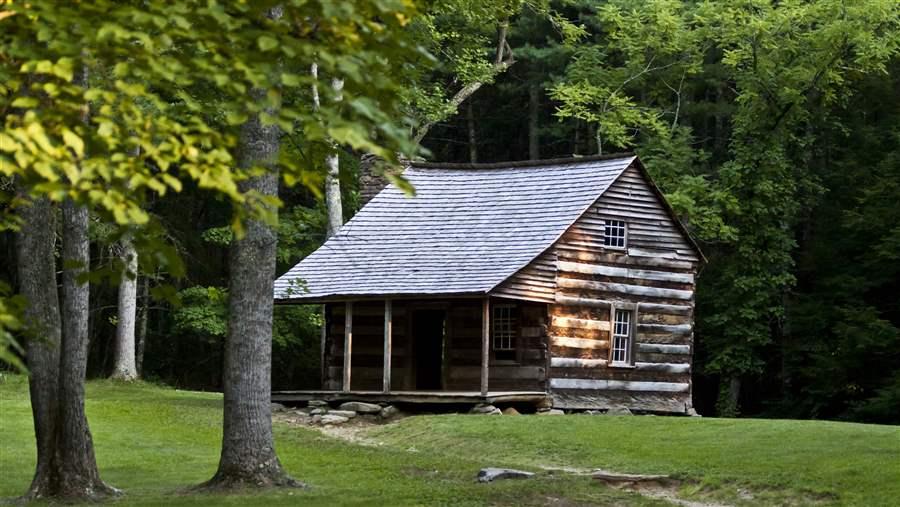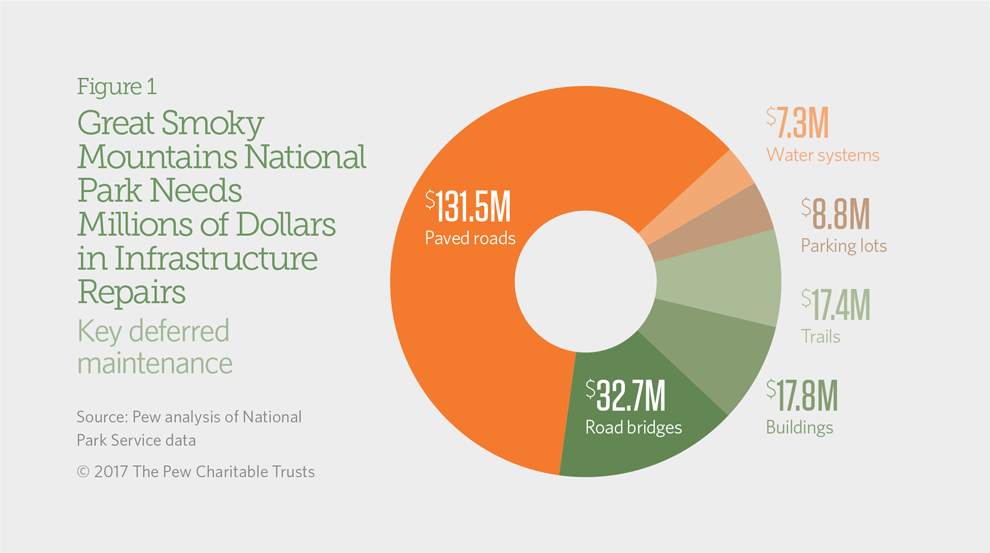Great Smoky Mountains National Park
North Carolina and Tennessee

Given the park’s year-round moderate climate, hiking is especially popular.
© Chris Swartwood/Aurora PhotosPew created this case study using National Park Service deferred maintenance data issued in fiscal year 2015. The information listed here may no longer reflect the NPS site’s current condition or maintenance requirements. To find the most up-to-date information, please use the National Park Repair Needs tool.
This case study was updated on July 31, 2017, to reflect newly released 2016 data and to correct references to calendar and fiscal year.
Overview
Straddling the North Carolina-Tennessee border, Great Smoky Mountains National Park is world-renowned for its biodiversity. More than 19,000 species share these 800 square miles of forest—the biggest concentration in an area its size in a temperate climate. The most iconic is the black bear, the symbol of the Smokies. About 1,500 live in the park—roughly two bears per square mile. The chance to spot one, in forests awash with wildflowers year-round, helped to draw more than 11 million visitors last year, more than any other national park.
Established in 1934, the park is also a window into southern Appalachian Mountains culture. Over hundreds of years, the Cherokee tribe, miners, loggers, and mountain homesteaders called it home. Nearly 80 of the buildings they constructed are still standing, nine of which are listed on the National Register of Historic Places.
Unfortunately, with millions of visitors comes substantial wear and tear. Great Smoky Mountains National Park has an estimated $233 million in deferred maintenance needs.

Building repairs account for $17.8 million of the park's $233 million maintenance backlog.
© Wray Sinclair/Aurora Photos
Maintenance challenges
Over 75 percent of needed repairs are associated with the road network. The park maintains over 200 miles of paved roads, tunnels, and bridges that allow visitors to traverse the mountainous landscape. Overuse and age have left the road network with over $175 million in needed maintenance.
Newfound Gap Road (U.S. 441), which bisects the park and offers breathtaking views and access to popular trailheads, requires $24.7 million in upgrades and repairs. Just south, Clingmans Dome Road, which climbs to one of the highest peaks in the Smokies, requires $3.4 million.
Aging buildings are another primary concern. The park’s headquarters is more than 75 years old and requires $5 million to repair its wooden structure and upgrade its heating and cooling systems. In the face of budget shortfalls, the National Park Service (NPS) has deferred this project for over 25 years. The nearby Sugarlands Visitor Center, a key destination that houses exhibits on wildlife, geology, and history, is in disrepair and needs to be totally reconstructed.1 Across the park in the Cades Cove Historic District, NPS needs nearly $350,000 to rehabilitate churches, a working grist mill, barns, smokehouses, and other 18th- and 19th-century structures.2 The repairs are part of $38 million in deferred maintenance for all historic sites.
Given the park’s year-round moderate climate, hiking is especially popular. But heavy use has worn down trails, and repairing them will cost $17.4 million. Restrooms at trailheads, campgrounds, and key destinations have aging water systems; fixing them, and ensuring adequate water for visitors, is a priority for park staff. These repairs and upgrades will require nearly $13 million.
The Great Smoky Mountains National Park is vital to my business. …However, disregarding needed infrastructure repairs in the Smokies to the tune of $230 million could have the potential to disrupt our business and others who work in our industry. Without working roads, bridges, and trails, many of our patrons could go elsewhere.Ed McAllister, owner of River Sports Outfitters
Recommendations
To address the maintenance needs at Great Smoky Mountains and other NPS sites in North Carolina, Tennessee, and across the country, Congress should:
- Ensure that infrastructure initiatives include provisions to address park maintenance.
- Provide dedicated annual federal funding for national park repairs.
- Enact innovative policy reforms to ensure that deferred maintenance does not escalate.
- Provide more highway funding for NPS maintenance needs.
- Create more opportunities for public-private collaboration and donations to help restore park infrastructure.
Great Smoky Mountains National Park Facts
2016
|
Visitor spending |
$942.7 million |
|
Jobs created by visitor spending |
14,700 |
|
Economic output |
$1.3 billion |
|
Labor income |
$426.9 million |
|
Visits |
11,312,786 |
|
Deferred maintenance (fiscal year 2015) |
$233.1 million |
Sources: National Park Service, “Annual Visitation Reports by Years: 2006 to 2016,” accessed Feb. 17, 2017, https://irma.nps.gov/Stats/SSRSReports/National Reports/Annual Visitation By Park (1979 - Last Calendar Year); National Park Service, “Visitor Spending Effects,” accessed Aug. 22, 2016, https://www.nps.gov/subjects/socialscience/vse.htm; National Park Service, “NPS Deferred Maintenance Reports,” accessed Aug. 19, 2016, https://www.nps.gov/subjects/plandesignconstruct/defermain.htm; Pew converted NPS data from this webpage and other NPS sources into a searchable database.
© 2017 The Pew Charitable Trusts
The Pew Charitable Trusts works alongside the National Parks Conservation Association, the National Trust for Historic Preservation, and other national and local groups to ensure that our national park resources are maintained and protected for future generations to enjoy.
Endnotes
- FSUNews.com, “Mountain of budget backlog repairs pile up in Smokies,” accessed April 19, 2017, http://www.fsunews.com/story/news/2015/04/06/smoky-mountains-maintenance/25386639/
- Ibid.












